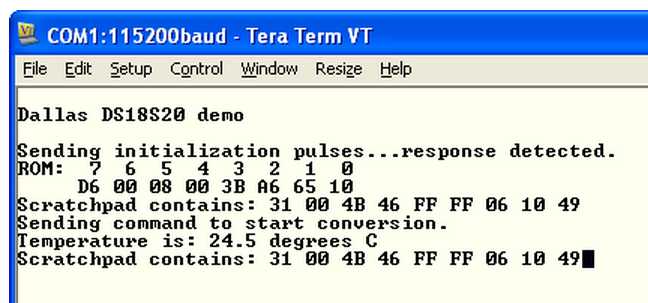标签:
One-wire Demo on the STM32F4 Discovery Board
Once I have the scratchpad with the temperature data, I simply use the values in bytes 0 and 1 to compute the temperature.
Here is the code for setting up the GPIO pin I‘ve selected:
/*
* Specify the port and pin used for 1-wire comms
*/
#define ONEWIRE_PIN_NUM 1
#define ONEWIRE_PIN_MASK (1<<ONEWIRE_PIN_NUM)
#define ONEWIRE_PORT GPIOC
#define ONEWIRE_CLK RCC_AHB1Periph_GPIOC
/*
* OneWire_Init hardware-specific configuration of 1-wire I/O
*/
static void OneWire_Init(void)
{
GPIO_InitTypeDef GPIO_InitStructure;
RCC_AHB1PeriphClockCmd(ONEWIRE_CLK, ENABLE); // route the clocks
GPIO_InitStructure.GPIO_Pin = ONEWIRE_PIN_MASK; // select the pin to modify
GPIO_InitStructure.GPIO_Mode = GPIO_Mode_OUT; // set the mode to output
GPIO_InitStructure.GPIO_Speed = GPIO_Speed_100MHz; // set the I/O speed to 100 MHz
GPIO_InitStructure.GPIO_OType = GPIO_OType_OD; // set the output type to open-drain
GPIO_InitStructure.GPIO_PuPd = GPIO_PuPd_NOPULL; // set the pull-up to none
GPIO_Init(ONEWIRE_PORT, &GPIO_InitStructure); // do the init
}
This design lets me define a port and pin by changing the macros at the top, without having to touch the code itself; less risk of changing all but one hard-coded operations that way.
Next, I need a set of macros for manipulating the registers associated with my 1-wire data pin. Here they are:
/*
* The following macros collapse direct accesses of the GPIO registers into
* single commands. Refer to stm32f4xx_gpio.c and the STM32F4xx Reference
* Manual (GPIO chapter) for details.
*/
#define ONEWIRE_INPUT_READ ONEWIRE_PORT->IDR&ONEWIRE_PIN_MASK
#define ONEWIRE_OUTPUT_HIGH ONEWIRE_PORT->BSRRL=ONEWIRE_PIN_MASK
#define ONEWIRE_OUTPUT_LOW ONEWIRE_PORT->BSRRH=ONEWIRE_PIN_MASK
#define ONEWIRE_CONFIG_OUTPUT ONEWIRE_PORT->MODER|=(GPIO_Mode_OUT<<(ONEWIRE_PIN_NUM*2))
#define ONEWIRE_CONFIG_INPUT ONEWIRE_PORT->MODER&=~(GPIO_MODER_MODER0<<(ONEWIRE_PIN_NUM*2))
These macros let me read from the pin when it‘s an input, set the pin high or low when it‘s an output, and configure the pin for either output or input operation.
Now let‘s look at what is involved in sending an initialization pulse:
static void SendInitialization(void)
{
ONEWIRE_OUTPUT_HIGH;
ONEWIRE_CONFIG_OUTPUT;
delay_usecs(500);
ONEWIRE_OUTPUT_LOW;
delay_usecs(500);
ONEWIRE_OUTPUT_HIGH;
ONEWIRE_CONFIG_INPUT;
delay_usecs(50);
}
The only interesting bit here is that whenever I switch the line from output to input, I need to make sure I first drive the output high. This is because the open-collector driver on the pin will clamp the line low otherwise, preventing the pin from being pulled up by the external resistor.
The function delay_usecs() does just what it says, delay a given number of microseconds. In my code, I used a spin-loop routine for the delay, but you can just as easily set up a timer for generating delays in hardware.
Next up is code for sending a byte. That is just a mix of sending 1s and 0s, based on the argument. Here is my routine:
static void SendByte(uint8_t val)
{
uint8_t n;
for (n=0; n<8; n++)
{
ONEWIRE_OUTPUT_LOW;
ONEWIRE_CONFIG_OUTPUT;
delay_usecs(5);
if (val & 1) ONEWIRE_OUTPUT_HIGH;
delay_usecs(95);
ONEWIRE_OUTPUT_HIGH;
delay_usecs(5);
val = val >> 1;
}
}
No rocket science here. Bring the line low to start a bit slot, wait 5 usecs, and check the bit to send. If sending a 1, drive the line high, else leave the line low. Wait the remaining 95 microseconds, then ensure the line is high. Rotate the byte to send, repeat until all bits are sent, done.
All that‘s left at the low level is reading a byte:
static uint8_t ReadByte(void)
{
uint8_t n;
uint8_t val;
val = 0;
for (n=0; n<8; n++)
{
val = val >> 1;
ONEWIRE_OUTPUT_LOW;
ONEWIRE_CONFIG_OUTPUT;
delay_usecs(15);
ONEWIRE_OUTPUT_HIGH;
ONEWIRE_CONFIG_INPUT;
delay_usecs(10);
if (ONEWIRE_INPUT_READ) val = val | 0x80;
delay_usecs(35);
}
return val;
}
In this case, the master needs to pull the line low to provide a bit slot, then wait a moment before releaseing the line. After another short delay, the master samples the data line. If the line is still low, the device is sending a 0. If the line is high, the device is sending a 1. Repeat for eight bits, you have a byte, and you‘re done.
With the low-level stuff out of the way, I just built up some simple functions for accessing the DS1820. Here is how to read the termperature after a termperature conversion command has completed:
static void ReportTemperature(void)
{
uint32_t val;
uint32_t t;
uint32_t frac;
uint8_t n;
SendInitialization();
delay_usecs(100);
SendByte(SKIP_ROM);
SendByte(READ_SCRATCHPAD);
for (n=0; n<9; n++)
{
pad[n] = ReadByte();
}
val = (pad[1] * 256 + pad[0]); // temp in 0.5 degs C
t = val;
val = val >> 1; // temp in degs C
frac = 0;
if ((val << 1) != t) frac = 5; // if the roll lost a bit, allow for 0.5 deg C
xprintf("\n\rTemperature is: %d.%d degrees C", val, frac);
}
This code builds the termperature from bytes 0 and 1 of the scratchpad. This value will be the termperature in 0.5 degC increments. My code rolls this value right one bit, then creates a fake floating-point value so the output looks correct. Note that you can use other values in the scratchpad to get finer resolution on the temperature value, if you like; consult the Maxim docs for details.
Here is a screenshot of my demo program as it appears in TeraTerm:

Here is a picture of my test setup:

As you can see, the 1-wire devices are easy to use and pretty forgiving.
I have built up networks of these devices spanning dozens of meters, run them down buried bore holes, and never had problems reading data. Communications can be a bit slow, since it takes many milliseconds to perform some of the operations, but if you don‘t need speed and want simple wiring, the 1-wire family rates a look.
Here is a zip of the source file for this code. Note that you will not be able to rebuild this code as-is, since it uses my custom STM32F4 libraries for UART comms and suchlike. However, I‘ve included the binary image, if you want to add a DS1820 to your Disco board and try out my program.
One-wire Demo on the STM32F4 Discovery Board
标签:
原文地址:http://www.cnblogs.com/shangdawei/p/4761510.html